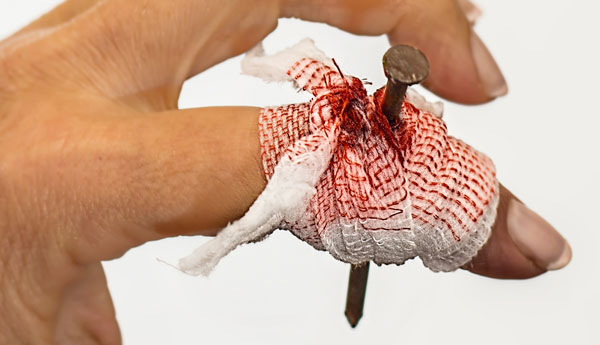
My apologies folks, this article comes a little later than anticipated. Warming weather around the homestead has meant my days are increasingly spent outside, rather than behind my keyboard. But with some rainy days upon me, I figure its time to discuss how to use the first aid kits we prepared in Farmyard First Aid: Creating a Kit.
Bandaging
The articles discussed in the bandaging section of the kit are almost self explanatory, but a little instruction never hurt anyone. Band-aids, of course, will work for any small laceration, while larger injuries will bring the gauze and tape into play. First lightly wash the injured area with a piece of gauze dampened with sanitizer. Then place a separate piece of gauze over the injury, before applying tape to every edge to hold it in place.
Sanitizing
This, of course, brings us to the topic of sanitization. To begin sanitizing an area, wash your hands with some hand sanitizer, and don your nitrile gloves. Neosporin and hand sanitizer will obviously do for a less severe wound, but for any sort of deep cut, flush the area with a wound wash. This saline-based solution does a great job not just of fighting bacteria, but will also flush away any dust, dirt or other foreign materials that have become lodged in the wound, and could cause infection. After treating with the above, I like to apply a coating of Calendula ointment, to help close the cut more quickly. If were talking about a light burn, Aloe Vera can help soothe the irritation, or (if you can find some), Urtica Urens ointment.
Aches and Allergies
This section is a little beyond my expertise, except to say to always read the directions on your medication, and never exceed recommended dosages. It doesn’t matter how bad your head hurts, it never hurts badly enough to enjoy needing a new liver.
Serious Wounds
Finally we come to the important section: serious injuries. The best way to prep for these is–and I cannot stress this enough–to get some basic training from a medical professional. Just like the First Aid/CPR class you took to be a lifeguard that summer you were 16, courses are offered to educate the public on how to handle a vast array of common medical emergencies, and use simple medical tools. Taking one could very well save your life, or that of a loved one.
While we’re here, however, let me fill you in on one important basic–how to use a tourniquet–with the caveat that you definitely need to practice it yourself with a training tourniquet. Tourniquets are useful in the event of deep cuts, gunshot wounds, or crushed limbs to keep an injured person stable until they can receive medical attention. After calling 911, determine the source of bleeding. Having the injured party lay down may help with this. Once found, apply direct pressure to the bleed. If this does not suffice, you’ll need to apply a tourniquet. As this could be painful, let the person know its coming.
Clear any clothing near the wound, as the tourniquet needs to be applied to the bare skin. Position the tourniquet on the limb between the wound and the heart, though never directly on a joint. If the wound occurs on a joint, place it above. Once the tourniquet is situated where you want it, pull the tail strap tight and twist the rod (known as a windlass) until it is tight. Finally, note down when you applied the tourniquet–some models will even have a space to note this on the device.
A humble homesteader based in an undisclosed location, Lars Drecker splits his time between tending his little slice of self-sustaining heaven, and bothering his neighbors to do his work for him. This is mainly the fault of a debilitating predilection for fishing, hunting, camping and all other things outdoors. When not engaged in any of the above activities, you can normally find him broken down on the side of the road, in some piece of junk he just “fixed-up.”

Chuck says
Thank you , always nice seeing an important reminder!